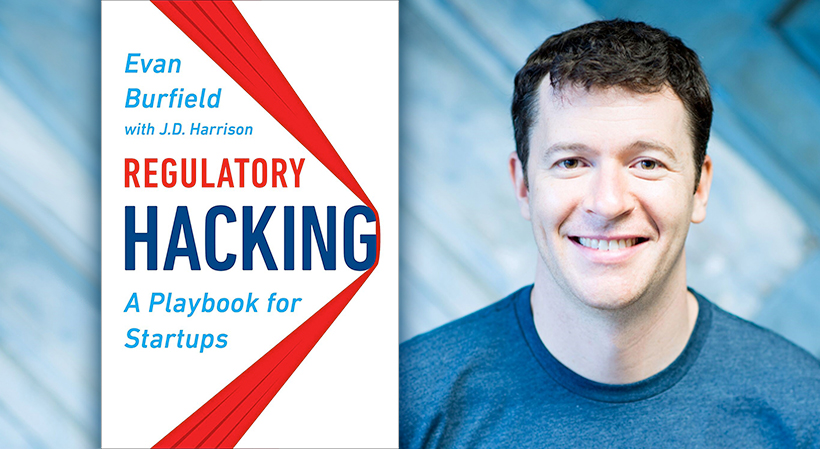The following is excerpted from “Regulatory Hacking: A Playbook for Startups” by Evan Burfield with J.D. Harrison with permission of Portfolio, an imprint of Penguin Publishing Group, a division of Penguin Random House LLC. Copyright © Evan Burfield, 2018.
Narrative
If you ask enough startup founders to tell you their stories, you’ll begin to pick up on some common themes. There are always some unique twists and turns and the characters will vary, but the standard narrative becomes familiar quickly. More often than not, it’s a story about identifying a gap in the market, racing to build a viable product, rushing to raise capital, scaling as quickly as your team and your technology will allow, and ultimately disrupting the status quo.
Carolyn and her cofounders at HopSkipDrive tell a different story.
The HopSkipDrive story, to hear Carolyn tell it, is about frantically coordinating three different carpools with three different families for three different children. It’s a story about arguing with your spouse over whose job is more important that day. It’s a story, she says simply, about an upset child who was late to soccer practice or was once again the last one waiting to be picked up from piano lessons.
The HopSkipDrive story is a story about working parents.
“We weren’t looking for a problem to solve,” says Carolyn, who with her cofounders Joanna and Janelle have eight children between them. “We were looking for a solution to a problem we all faced every day a problem no one else seemed to be solving.” Starting a startup was merely “our way to solve our own problem.”
With that in mind, the co-founders set out to build a service they would be comfortable using for their own children, which meant going above and beyond when it came to safety and peace of mind. That’s why the three designed and implemented an extensive fifteen-point background check and driver certification process and integrated real-time vehicle safety monitoring into their app.
As Carolyn puts it, “First and foremost, we’re moms. We worry about our kids, so we’ve built in safety measures before the ride, during the ride, and behind the scenes that makes us feel comfortable sending our kids with Care-Drivers, too.”
Joanna echoed the same sentiment a year later, telling mommy blogger Emma Johnson, “It had to be something we would feel comfortable using with our own kids,” who she later noted were attending five different schools and participating in a combined seventeen activities when HopSkipDrive was first conceived. She was quick to add that “all of our children now use HopSkipDrive all the time.”
In addition, Carolyn points out, “We’re three women, three mothers, all of us first-time founders, and two of us were over 40 when we started. We’re exactly the opposite of what you see in Silicon Valley.”
That’s the narrative they have carefully crafted: for busy moms, by busy moms.
Related: 5 Ways to Tell Your Brand’s Story Using Creative Design
But there’s more to their story.
The chapters Carolyn tends to gloss over with most audiences include her 15 years as an attorney after graduating from UCLA Law School, starting and running her own practice, and launching and managing two nonprofits. Joanna doesn’t lead with her business degrees from both Stanford and Wharton, nor does she go out of her way to mention her senior executive roles at a publishing firm, a bank, and a tech company. Depending on the audience in the room, Janelle may never bring up her studies at Wharton, either, or how the boutique marketing company she started has worked with the likes of Nestlé and Visa.
Those were details that Donna and I heard when they pitched 1776 for a seed investment.
The story they tell to most audiences is about three everyday moms tackling the mundane challenges faced by every other working mom. It’s down-to-earth and relatable, bordering on homey, not entrepreneurial and opportunistic. It’s for moms, by moms. Not for moms, by savvy, successful, Ivy League entrepreneurs.
After all, which would make you feel more at ease putting your child in a car with a stranger?
Much of the credit for the story and the brand HopSkipDrive has crafted belongs to Janelle.
“Janelle is a branding and storytelling guru,” Carolyn praises. “She knows how to convey the emotion about our brand in a way that s very compelling and approachable and in a way to create a sense of trust amongst families who five years ago would never have imagined using a service like this.”
While the HopSkipDrive team had the luxury of understanding their target customers more intimately than most, the success of the brand comes down to one core value: empathy.
According to Janelle, “While Carolyn, Joanna, and I were all facing the same challenge of getting our kids where they needed to go, we each have very different parenting stories and sensibilities. The brand had to be relatable and understanding of every parents unique struggle.” The team dedicated time early on to working through exactly what the brand should stand for and why they believed so passionately in what they were doing as moms and as founders.
It starts with the way Janelle and the team frame their company to customers. In headlines, you’ll find HopSkipDrive commonly referred to as “Uber for kids.” But you won’t find the co-founders promoting that analogy. Instead, they frequently describe the proposition to parents as caregivers on wheels. It’s a subtle distinction, but as Janelle points out, it’s an important one for wary parents.
“We are very purposeful in the way we talk about what we do and how it supports parents and families. Our website breaks almost every digital marketing rule. We don t have lots of white space. The copy is long and explanatory. There aren’ t quippy analogies. We crafted our story to support obsessive parents, like us, who want to know every detail and need real assurances that choosing to trust their child s transportation to a CareDriver is safe.” It helps that the voice they’ve created is easy to understand and authentic.
And it’s not just potential customers for whom the story matters.
“We’ re dealing with the most vulnerable population in society, young children,” Carolyn says. “When you’re doing that, you have to live and breathe trust and safety, and not just in your actions, but in every interaction you’re having with customers, with drivers, with employees, and with regulators.”
Make no mistake, Uber’s strategy and subsequent record of success early on wasn’t lost on the HopSkipDrive co-founders. While they were building their own startup, they watched as the Silicon Valley poster child bulldozed its way into new city after new city with seemingly little regard for existing regulations, all in the name of innovation and a better consumer experience.
“For us to adopt that same model and go into the California Public Utilities Commission like a bull in a china shop and say, ‘We realize you don’t have rules yet for transporting unaccompanied minors, so guess what, were just gonna do whatever the hell we want’… that wouldn’t have been the attitude that showed we were all about the same things they are trust and safety,” Carolyn says.
Instead, they leaned into sharing the same goals as their regulators, offering them the story about empathy and safety they told to every parent who would listen.
“We knew that the fundamental purpose of these regulatory agencies was safety,” she says. “Once we could show them, because of who we were and where we were coming at this problem from, that safety was our top priority, too, the level of trust and the willingness to engage went up exponentially.”
She adds, “We went in from day one knowing we didn’t want to spend our time fighting with people all day long every day. We wanted to figure out a way to make it work for everyone. We wanted to find ways to negotiate that made everyone in the room, including the regulators, feel like they had won.”
Sign Up: Receive the StartupNation newsletter!
The narrative imperative
If you want to be successful as a founder, you’ll have to become effective at pitching your startup, or have a co-founder who is. There’s a reason why most accelerator programs spend at least as much time coaching you on your pitch as helping you fine-tune your business model. As nice as it is to believe that a superior idea or technology will win on its merits, the truth is that many ideas and technologies will never see the light of day if someone who believes in them cannot learn to tell a compelling story.
Narrative matters to all startups, but there are three ways in which it matters uniquely to regulated startups.
First, as a regulatory hacker striving to further the public interest, you’re solving important problems that positively impact real people’s lives. You can use that to your advantage. Everyone wants to believe that there are entrepreneurs in the world trying to cure diseases or save the planet or eliminate traffic.
Second, since you operate in a complex market, you need to find a straightforward way of communicating what you do. It takes skill and practice to explain your “artificial intelligence demand-response optimizer for electric utilities” in a way that people can intuitively understand and get excited about. Even more challenging, you have to explain your complex market in a way that overcomes people’s often-mistaken assumptions. You don’t want people to assume they know what your education startup does on the basis of their experiences at school, or the challenges of your healthcare startup based on their doctor’s visit.
Third, simpler startups are often preaching to the converted, sharing their narrative with investors, tech media, and perhaps end users. As a regulated startup, your narrative is so important because to unlock your market you often have to preach to the uninitiated as well, such as citizens, influencers, policymakers and advocacy groups, and other potential stakeholders, which is why crafting, refining, and effectively delivering your narrative is of paramount importance. If you want influential and powerful people to help you, and to engage other influential and powerful people on your behalf, then you need to arm them with a simple, compelling story that they can use and share.
“Regulatory Hacking: A Playbook for Startups” is available now at fine booksellers and can be purchased via StartupNation.com.






